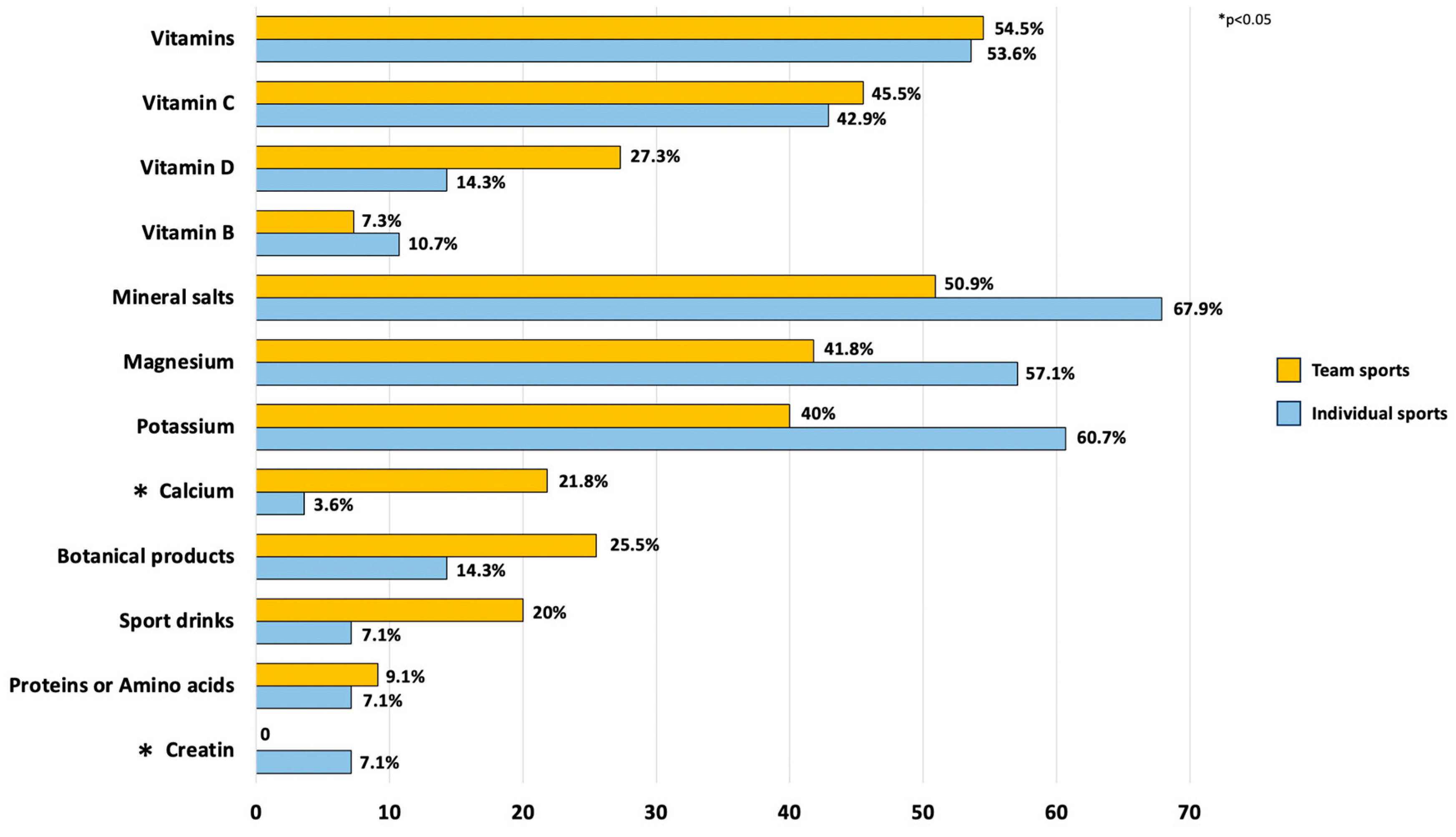High Use of Dietary Supplements and Low Adherence to the Mediterranean Diet Among Italian Adolescents: Results from the EduALI Project
Abstract
1. Introduction
2. Materials and Methods
2.1. Study Design and Participants
2.2. Data Collection
2.2.1. Sociodemographic and Anthropometric Parameters
2.2.2. Physical Activity
2.2.3. Use of Dietary Supplements
2.2.4. Eating Habits
2.3. Statistical Analysis
3. Results
3.1. Use of Dietary Supplements
3.2. Eating Habits
3.3. Sub-Analysis Categorized by Type of Sport
4. Discussion
Supplementary Materials
Author Contributions
Funding
Institutional Review Board Statement
Informed Consent Statement
Data Availability Statement
Conflicts of Interest
Abbreviations
| FFQ | Food Frequency Questionnaire |
| MD | Mediterranean Diet |
| IPAQ | International Physical Activity Questionnaire |
| BMI | Body mass index |
References
- Capra, M.E.; Stanyevic, B.; Giudice, A.; Monopoli, D.; Decarolis, N.M.; Esposito, S.; Biasucci, G. Nutrition for Children and Adolescents Who Practice Sport: A Narrative Review. Nutrients 2024, 16, 2803. [Google Scholar] [CrossRef] [PubMed]
- McKeown, A.; Nelson, R. Independent decision making of adolescents regarding food choice. Int. J. Consum. Stud. 2018, 42, 469–477. [Google Scholar] [CrossRef]
- Chavez-Ugalde, I.Y.; de Vocht, F.; Jago, R.; Adams, J.; Ong, K.K.; Forouhi, N.G.; Colombet, Z.; Ricardo, L.I.C.; van Sluijs, E.; Toumpakari, Z. Ultra-processed food consumption in UK adolescents: Distribution, trends, and sociodemographic correlates using the National Diet and Nutrition Survey 2008/09 to 2018/19. Eur. J. Nutr. 2024, 63, 2709–2723. [Google Scholar] [CrossRef]
- Global Nutrition Target Collaborators. Global, Regional, and National Progress towards the 2030 Global Nutrition Targets and Forecasts to 2050: A Systematic Analysis for the Global Burden of Disease Study 2021. Lancet 2024, 404, 2543–2583. [Google Scholar] [CrossRef]
- Heslin, A.M.; McNulty, B. Adolescent nutrition and health: Characteristics, risk factors and opportunities of an overlooked life stage. Proc. Nutr. Soc. 2023, 82, 142–156. [Google Scholar] [CrossRef]
- Mistretta, A.; Marventano, S.; Antoci, M.; Cagnetti, A.; Giogianni, G.; Nolfo, F.; Rametta, S.; Pecora, G.; Marranzano, M. Mediterranean diet adherence and body composition among Southern Italian adolescents. Obes. Res. Clin. Pract. 2017, 11, 215–226. [Google Scholar] [CrossRef] [PubMed]
- Nardone, P.; Pierannunzio, D.; Ciardullo, S.; Lazzeri, G.; Cappello, N.; Spinelli, A.; the 2018 HBSC-Italia Group. Dietary habits among Italian adolescents and their relation to socio-demographic characteristics. Ann. Ist. Super. Sanita 2020, 56, 504–513. [Google Scholar] [CrossRef]
- Dinu, M.; Lotti, S.; Pagliai, G.; Pisciotta, L.; Zavatarelli, M.; Borriello, M.; Solinas, R.; Galuffo, R.; Clavarino, A.; Acerra, E.; et al. Mediterranean Diet Adherence in a Sample of Italian Adolescents Attending Secondary School—The “#facciamoComunicAzione” Project. Nutrients 2021, 13, 2806. [Google Scholar] [CrossRef]
- Slawson, D.L.; Fitzgerald, N.; Morgan, K.T. Position of the Academy of Nutrition and Dietetics: The role of nutrition in health promotion and chronic disease prevention. J. Acad. Nutr. Diet. 2013, 113, 972–979. [Google Scholar] [CrossRef]
- European Commission. Food Supplement. Available online: https://food.ec.europa.eu/food-safety/labelling-and-nutrition/food-supplements_en (accessed on 18 December 2024).
- Bailey, R.L.; Gahche, J.J.; Lentino, C.V.; Dwyer, J.T.; Engel, J.S.; Thomas, P.R.; Betz, J.M.; Sempos, C.T.; Picciano, M.F. Dietary supplement use in the United States, 2003–2006. J. Nutr. 2011, 141, 261–266. [Google Scholar] [CrossRef]
- del Balzo, V.; Vitiello, V.; Germani, A.; Donini, L.M.; Poggiogalle, E.; Pinto, A. A cross-sectional survey on dietary supplements consumption among Italian teen-agers. PLoS ONE 2014, 9, e100508. [Google Scholar] [CrossRef] [PubMed]
- Anselmo, F.; Driscoll, M.S. Deleterious side effects of nutritional supplements. Clin. Dermatol. 2021, 39, 745–756. [Google Scholar] [CrossRef] [PubMed]
- Craig, C.L.; Marshall, A.L.; Sjöström, M.; Bauman, A.E.; Booth, M.L.; Ainsworth, B.E.; Pratt, M.; Ekelund, U.; Yngve, A.; Sallis, J.F.; et al. International physical activity questionnaire: 12-country reliability and validity. Med. Sci. Sports Exerc. 2003, 35, 1381–1395. [Google Scholar] [CrossRef]
- Fernández-Bustos, J.G.; Infantes-Paniagua, Á.; Cuevas, R.; Contreras, O.R. Effect of Physical Activity on Self-Concept: Theoretical Model on the Mediation of Body Image and Physical Self-Concept in Adolescents. Front. Psychol. 2019, 10, 1537. [Google Scholar] [CrossRef] [PubMed]
- Gallè, F.; Valeriani, F.; De Giorgi, A.; Angelillo, S.; Bargellini, A.; Bianco, A.; Bianco, L.; Caggiano, G.; Colucci, M.E.; Coniglio, M.A.; et al. Assessment of dietary supplement consumption among Italian university students: The multicenter DiSCo study. Nutrition 2023, 107, 111902. [Google Scholar] [CrossRef]
- Buscemi, S.; Rosafio, G.; Vasto, S.; Massenti, F.M.; Grosso, G.; Galvano, F.; Rini, N.; Barile, A.M.; Maniaci, V.; Cosentino, L.; et al. Validation of a food frequency questionnaire for use in Italian adults living in sicily. Int. J. Food Sci. Nutr. 2015, 66, 426–438. [Google Scholar] [CrossRef]
- Sofi, F.; Dinu, M.; Pagliai, G.; Marcucci, R.; Casini, A. Validation of a literature-based adherence score to Mediterranean diet: The MEDI-LITE score. Int. J. Food Sci. Nutr. 2017, 68, 757–762. [Google Scholar] [CrossRef]
- CREA-Centro di Ricerca Alimenti e la Nutrizione. Linee Guida per una Sana Alimentazione. 2018. Available online: https://www.crea.gov.it/en/web/alimenti-e-nutrizione/-/linee-guida-per-una-sana-alimentazione-2018 (accessed on 18 December 2024).
- Tognon, G.; Hebestreit, A.; Lanfer, A.; Moreno, L.A.; Pala, V.; Siani, A.; Tornaritis, M.; De Henauw, S.; Veidebaum, T.; Molnár, D.; et al. Mediterranean diet, overweight and body composition in children from eight European countries: Cross-sectional and prospective results from the IDEFICS study. Nutr. Metab. Cardiovasc. Dis. 2014, 24, 205–213. [Google Scholar] [CrossRef]
- Desbrow, B.; McCormack, J.; Burke, L.M.; Cox, G.R.; Fallon, K.; Hislop, M.; Logan, R.; Marino, N.; Sawyer, S.M.; Shaw, G.; et al. Sports Dietitians Australia Position Statement: Sports Nutrition for the Adolescent Athlete. Int. J. Sport Nutr. Exerc. Metab. 2014, 24, 570–584. [Google Scholar] [CrossRef]
- Moreno, L.A.; Gottrand, F.; Huybrechts, I.; Ruiz, J.R.; González-Gross, M.; DeHenauw, S. Nutrition and lifestyle in european adolescents: The HELENA (Healthy Lifestyle in Europe by Nutrition in Adolescence) study. Adv. Nutr. 2014, 5, 615s–623s. [Google Scholar] [CrossRef]
- Winpenny, E.M.; Greenslade, S.; Corder, K.; Van Sluijs, E.M.F. Diet Quality through Adolescence and Early Adulthood: Cross-Sectional Associations of the Dietary Approaches to Stop Hypertension Diet Index and Component Food Groups with Age. Nutrients 2018, 10, 1585. [Google Scholar] [CrossRef] [PubMed]
- Hulland, S.C.; Trakman, G.L.; Alcock, R.D. Adolescent athletes have better general than sports nutrition knowledge and lack awareness of supplement recommendations: A systematic literature review. Br. J. Nutr. 2024, 131, 1362–1376. [Google Scholar] [CrossRef] [PubMed]
- Jagim, A.R.; Merfeld, B.R.; Ambrosius, A.; Carpenter, M.; Fields, J.B.; Jones, M.T. Nutrition Knowledge and Perceived Dietary Requirements of Adolescent Student-Athletes: A Pilot Study. Nutrients 2025, 17, 133. [Google Scholar] [CrossRef] [PubMed]
- Noronha, D.C.; Santos, M.; Santos, A.A.; Corrente, L.G.A.; Fernandes, R.K.N.; Barreto, A.C.A.; Santos, R.G.J.; Santos, R.S.; Gomes, L.P.S.; Nascimento, M.V.S. Nutrition Knowledge is Correlated with a Better Dietary Intake in Adolescent Soccer Players: A Cross-Sectional Study. J. Nutr. Metab. 2020, 2020, 3519781. [Google Scholar] [CrossRef]
- Zdešar Kotnik, K.; Jurak, G.; Starc, G.; Golja, P. Faster, Stronger, Healthier: Adolescent-Stated Reasons for Dietary Supplementation. J. Nutr. Educ. Behav. 2017, 49, 817–826.e1. [Google Scholar] [CrossRef]
- Zdešar Kotnik, K.; Jurak, G.; Starc, G.; Puc, M.; Golja, P. Use of dietary supplements in differently physically active adolescents. J. Food Nutr. Res. 2018, 57, 231–241. [Google Scholar]
- Tiwari, K. Supplement (mis)use in adolescents. Curr. Opin. Pediatr. 2020, 32, 471–475. [Google Scholar] [CrossRef]
- Barretto, J.R.; Gouveia, M.A.d.C.; Alves, C. Use of Dietary Supplements by Children and Adolescents. J. Pediatr. (Rio. J.) 2023, 100, S31–S39. [Google Scholar] [CrossRef]
- Giannopoulou, I.; Noutsos, K.; Apostolidis, N.; Bayios, I.; Nassis, G.P. Performance level affects the dietary supplement intake of both individual and team sports athletes. J. Sports Sci. Med. 2013, 12, 190–196. [Google Scholar]
- Tawfik, S.; El Koofy, N.; Moawad, E.M.I. Patterns of Nutrition and Dietary Supplements Use in Young Egyptian Athletes: A Community-Based Cross-Sectional Survey. PLoS ONE 2016, 11, e0161252. [Google Scholar] [CrossRef]
- Petróczi, A.; Naughton, D.P.; Pearce, G.; Bailey, R.; Bloodworth, A.; McNamee, M. Nutritional Supplement Use by Elite Young UK Athletes: Fallacies of Advice Regarding Efficacy. J. Int. Soc. Sports Nutr. 2008, 5, 22. [Google Scholar] [CrossRef] [PubMed]


| Recommended Frequency of Consumption | All (n = 83) | |
|---|---|---|
| Red meat, g/week | 0–100 | 367.0 ± 248.2 |
| White meat, g/week | 200–300 | 319.5 ± 246.4 |
| Sliced meats, g/week | 0–50 | 125.9 ± 113.5 |
| Fish, g/week | 450 | 180.1 ± 165.1 |
| Legumes, g/week | 360 | 191.6 ± 192.2 |
| Cheeses, g/week | 250 | 289.2 ± 167.6 |
| Milk, g/day | 200 | 93.6 ± 82.3 |
| Yogurt, g/day | 125 | 41.3 ± 44.5 |
| Pasta or rice, g/day | 100 | 99.7 ± 42.1 |
| Bread, g/day | 150 | 42.4 ± 31.2 |
| Potatoes, g/week | 400 | 316.6 ± 261.8 |
| Vegetables, g/day | 400 | 98.5 ± 78.8 |
| Fresh fruit, g/day | 240–360 | 109.7 ± 90.6 |
| Olive oil, g/day | 30 | 8.1 ± 5.5 |
Disclaimer/Publisher’s Note: The statements, opinions and data contained in all publications are solely those of the individual author(s) and contributor(s) and not of MDPI and/or the editor(s). MDPI and/or the editor(s) disclaim responsibility for any injury to people or property resulting from any ideas, methods, instructions or products referred to in the content. |
© 2025 by the authors. Licensee MDPI, Basel, Switzerland. This article is an open access article distributed under the terms and conditions of the Creative Commons Attribution (CC BY) license (https://creativecommons.org/licenses/by/4.0/).
Share and Cite
Lotti, S.; Tristan Asensi, M.; Cretì, D.; Mollo, E.; Sarti, A.; Sciattella, F.; Dinu, M.; Colombini, B.; Rizzo, L.; Sofi, F. High Use of Dietary Supplements and Low Adherence to the Mediterranean Diet Among Italian Adolescents: Results from the EduALI Project. Nutrients 2025, 17, 2213. https://doi.org/10.3390/nu17132213
Lotti S, Tristan Asensi M, Cretì D, Mollo E, Sarti A, Sciattella F, Dinu M, Colombini B, Rizzo L, Sofi F. High Use of Dietary Supplements and Low Adherence to the Mediterranean Diet Among Italian Adolescents: Results from the EduALI Project. Nutrients. 2025; 17(13):2213. https://doi.org/10.3390/nu17132213
Chicago/Turabian StyleLotti, Sofia, Marta Tristan Asensi, Donato Cretì, Erika Mollo, Armando Sarti, Francesco Sciattella, Monica Dinu, Barbara Colombini, Luigi Rizzo, and Francesco Sofi. 2025. "High Use of Dietary Supplements and Low Adherence to the Mediterranean Diet Among Italian Adolescents: Results from the EduALI Project" Nutrients 17, no. 13: 2213. https://doi.org/10.3390/nu17132213
APA StyleLotti, S., Tristan Asensi, M., Cretì, D., Mollo, E., Sarti, A., Sciattella, F., Dinu, M., Colombini, B., Rizzo, L., & Sofi, F. (2025). High Use of Dietary Supplements and Low Adherence to the Mediterranean Diet Among Italian Adolescents: Results from the EduALI Project. Nutrients, 17(13), 2213. https://doi.org/10.3390/nu17132213







